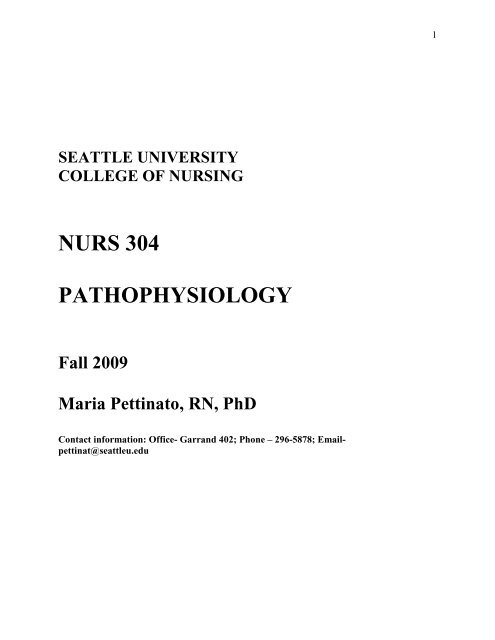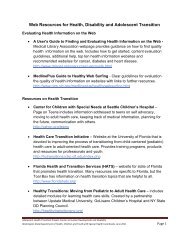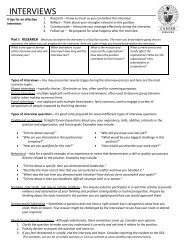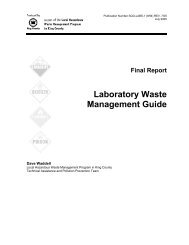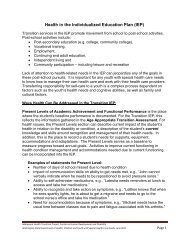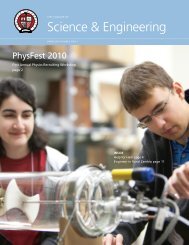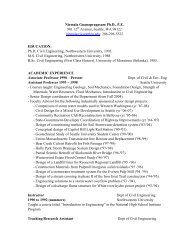SEATTLE UNIVERSITY COLLEGE OF NURSING NURS 304 ...
SEATTLE UNIVERSITY COLLEGE OF NURSING NURS 304 ...
SEATTLE UNIVERSITY COLLEGE OF NURSING NURS 304 ...
Create successful ePaper yourself
Turn your PDF publications into a flip-book with our unique Google optimized e-Paper software.
1<br />
<strong>SEATTLE</strong> <strong>UNIVERSITY</strong><br />
<strong>COLLEGE</strong> <strong>OF</strong> <strong><strong>NURS</strong>ING</strong><br />
<strong>NURS</strong> <strong>304</strong><br />
PATHOPHYSIOLOGY<br />
Fall 2009<br />
Maria Pettinato, RN, PhD<br />
Contact information: Office- Garrand 402; Phone – 296-5878; Emailpettinat@seattleu.edu
2<br />
<strong>SEATTLE</strong> <strong>UNIVERSITY</strong> <strong>COLLEGE</strong> <strong>OF</strong> <strong><strong>NURS</strong>ING</strong><br />
COURSE: N<strong>304</strong> Pathophysiology QUARTER: Fall 2009<br />
MON TUES WED THURS FRI<br />
September 21 22 23 24<br />
Intro to Patho<br />
Concepts,<br />
Immune System<br />
25<br />
28 29<br />
Inflammation ,Altered<br />
Immune Function<br />
October 5 6<br />
Exam # 1<br />
Fluids & Electrolytes<br />
12 13<br />
Urinary Disorders,<br />
Respiratory Disorders<br />
19 20<br />
ABG analysis and<br />
examples<br />
26 27<br />
Exam # 2, Genetics<br />
November 2 3<br />
Circulatory II<br />
30 October 1<br />
Disorders of<br />
Hemostasis,<br />
Neoplasia<br />
7 8<br />
Fluids &<br />
Electrolytes,<br />
Urinary Disorders<br />
14 15<br />
Respiratory,<br />
Acid/Base<br />
Imbalances<br />
21 22<br />
Genetics<br />
28 29<br />
Circulatory I<br />
4 5<br />
Cardiovascular<br />
2<br />
9<br />
16<br />
23<br />
30<br />
6<br />
9 10<br />
Musculoskeletal<br />
Disorders<br />
16 17<br />
Neuro Disorders<br />
23 24<br />
HIV Infection<br />
11 12<br />
Exam # 3,<br />
Neuro Disorders<br />
18 19<br />
Endocrine<br />
25 26-Thanksgiving-<br />
No Class<br />
13<br />
20<br />
27<br />
30 December 1<br />
GI Disorders<br />
2 3- Last Class,<br />
Reproductive<br />
Disorders<br />
4
3<br />
7 8 9 10-Final Exam-<br />
12PM-1:50PM<br />
11<br />
<strong>SEATTLE</strong> <strong>UNIVERSITY</strong> SCHOOL <strong>OF</strong> <strong><strong>NURS</strong>ING</strong><br />
Course Number, Title: N<strong>304</strong> - Pathophysiology<br />
Credits: 6<br />
Lectures: Tues, Thurs 12:30PM – 3:25PM in Pigt. 103<br />
Prerequisites:<br />
Placement:<br />
Faculty:<br />
Office Hours:<br />
BIOL 200, BIOL 210. BIOL 220 recommended<br />
Nursing, Sophomore/Junior year<br />
Open to non-majors<br />
Maria Pettinato, RN, PhD<br />
Garrand 402<br />
Phone: (206) 296- 5878<br />
e-mail: pettinat@seattleu.edu - This is the best way to reach me.<br />
Tuesdays, Thursdays 11AM-12PM, Fridays, 12PM-1PM or by<br />
appointment<br />
Catalog Description:<br />
A conceptual approach to alterations in structure and function resulting from stressors on the<br />
human body. Course will review the cellular and molecular basis of these alterations. The course<br />
will examine pathophysiologic mechanisms of disease such as inflammation, genetic alterations,<br />
immune responses, and alteration in the functions of body systems.<br />
Course Objectives: On completion of this course the learner will:<br />
1. Compare normal human anatomy and physiology to pathophysiological mechanisms in<br />
dysfunction.<br />
2. Demonstrate an understanding of selected alterations in structure and function and the<br />
clinical manifestations of those alterations.<br />
3. Identify the risk factors for selected mechanisms of disease.<br />
4. Relate compensatory mechanisms to adaptation and dysfunction.
4<br />
Required Texts:<br />
Pettinato, M. (2009). <strong>NURS</strong> <strong>304</strong> Course Syllabus. Seattle: Seattle University.<br />
Huether, Sue E. & McCance, Kathryn L. (2008) Understanding Pathophysiology. (4th<br />
ed.). Philadelphia, PA: Mosby.<br />
Venes, D., & Thomas, C. (eds). (2005). Taber’s cyclopedic medical dictionary (20 th ed.).<br />
Philadelphia: F.A. Davis. Or any medical dictionary.<br />
Optional Texts:<br />
Huether, S.E. & McCance, K.L. (2008). Study Guide and Workbook for Understanding<br />
pathophysiology (4th ed.). Philadelphia, PA: Mosby.<br />
Shaw, M. (2004). Pathophysiology made incredibly easy (3 rd ed.). Philadelphia, PA:<br />
Mosby.<br />
Referral to Disabilities Services:<br />
If you have, or think you may have, a disability (including an „invisible disability‟ such<br />
as a learning disability, a chronic health problem, or a mental health condition) that interferes<br />
with your performance as a student in this class, you are encouraged to discuss your needs and<br />
arrange support services and/or accommodations through Disabilities Services staff in the<br />
Learning Center, Loyola 100, (206) 296-5740.<br />
If English is not your first language and you have trouble finishing the exams in a timely<br />
fashion, please come talk to me.<br />
Standards of Conduct:<br />
Statement from the Seattle University Code of Student Conduct Handbook:<br />
“Standards of conduct assist each student in the development of a responsible lifestyle rewarding<br />
to the individual student, respectful of the rights of others, and compatible with the legal norms<br />
of society. It is neither possible nor necessary to specify every instance of behavior or<br />
misconduct that could result in disciplinary action against a student. Conduct that evidences<br />
good intentions, mature consideration of the foreseeable consequences, and respect for the rights<br />
and property of others generally will not conflict with University standards.” (Code, p. 9)<br />
Refer to the Code of Student Conduct regarding the following areas: Demonstrate Respect for:<br />
Self, Others, Relationships, Community, Honesty, and Property.<br />
(Code, pp. 5-7).
5<br />
Seattle University Nondiscrimination Policy<br />
Seattle University does not discriminate on the basis of race, color, religion, sex, national origin,<br />
age, disability, marital status, sexual orientation, gender identity, political ideology or status as a<br />
Vietnam-era or special disabled veteran in the administration of any of its education policies,<br />
admission policies, scholarship and loan programs, athletics, and other school-administered<br />
policies and programs, or in its employment related policies and practices.<br />
All University policies, practices and procedures are administered in a manner consistent with<br />
Seattle University‟s Catholic and Jesuit identity and character. Inquiries relating to these policies<br />
may be referred to the University's Assistant Vice President for Human Resources and Equal<br />
Opportunity Officer. Consistent with the requirements of Title IX of the Education Amendments<br />
of 1972 and its implementing regulations, Seattle University has designated three individuals<br />
responsible for coordinating the University's Title IX compliance. Students or employees with<br />
concerns or complaints about discrimination on the basis of sex in employment or an education<br />
program or activity may contact any one of the following Title IX coordinators:<br />
Gerald Huffman, Assistant Vice President for Human Resources<br />
University Services Building 107 (206) 296-5869<br />
huffmaje@seattleu.edu<br />
Dr. Michele Murray, Assistant Vice President<br />
Student Center 140B (206) 296-6066<br />
mmurray@seattleu.edu<br />
Dr. Jacquelyn Miller, Associate Provost for Academic Affairs<br />
Administration 104 (206) 296-5446<br />
jcmiller@seattleu.edu<br />
Individuals may also contact the Office for Civil Rights of the U.S. Department of Education.<br />
Teaching Strategies:<br />
To acknowledge multiple learning styles, this course offers multiple teaching and learning<br />
approaches. These approaches include:<br />
1. Lecture, including active question and answer opportunities.<br />
2. ANGEL - Seattle University Web-based instructional technology which will include course<br />
information such as lecture notes and PowerPoint images.<br />
3. Study group(s) led by experienced tutor (times and location TBA).
6<br />
<strong>NURS</strong> <strong>304</strong> Class Notes:<br />
Class notes and/or PowerPoints for each lecture will be available on ANGEL. Students can<br />
directly access ANGEL from SU front webpage.<br />
You must have a Seattle University email account to sign on to ANGEL. Please obtain one<br />
from IMS if you have not already done so. If you are a first-time user on ANGEL, i.e. you have<br />
never had any SU courses that use ANGEL, your ANGEL log on ID and password will both be<br />
the same as your SU e-mail user ID. If you have previously used ANGEL and have changed<br />
your password in your previous course, your password may be the one that you have selected.<br />
**Important: You cannot use your hotmail, yahoo, aol, or other outside e-mail address**<br />
Evaluation Methods and Description of Assignments:<br />
The final grade will be determined based on the following evaluation methods:<br />
4 exams 25% each<br />
Total 100%<br />
There will be 3 exams of multiple choice questions. The 4 th exam will include the last unit of<br />
new material, plus questions that draw on your knowledge from the entire quarter. It will only<br />
include multiple choice questions as well. However, the ability to incorporate a variety of<br />
information learned throughout the quarter will be necessary process for the final exam as it will<br />
include some specific patient case scenarios in which the student will be required to prioritize<br />
and comprehend information as a critical thinking beginning nurse.<br />
Final grade distribution is as follows (minimum pass grade is C or 2.0)<br />
College of Nursing Scale University Scale<br />
94-100 A 4.0 Superior<br />
90-93 A- 3.7<br />
87-89 B+ 3.3<br />
83-86 B 3.0 Good<br />
80-82 B- 2.7<br />
76-79 C+ 2.3<br />
* 73-75 C 2.0 Adequate<br />
70-72 C- 1.7<br />
66-69 D+ 1.3<br />
63-65 D 1.0 Poor<br />
60-62 D- 0.7<br />
Below 60 F 0.0 Failing<br />
* Minimum passing grade for nursing courses
7<br />
***A grade of C (2.0), that is 73%, is the minimum passing grade in all BSN Nursing<br />
Courses***<br />
Special Instructions:<br />
Cell phones and pagers must be turned "off" during class. Calls and pager messages are<br />
disruptive to me and the other students in the class.<br />
Test make-up procedures: If you are not able to take the test at the scheduled time, you must<br />
notify me by phone or e-mail prior to class. Failure to do so will forfeit your right to take<br />
the make-up test.<br />
If you are having difficulty studying for this class or taking exams, I encourage you to seek<br />
assistance from the Learning Resource Center in Loyola 100. Take advantage of this resource!<br />
Do not wait until you have failed 2 exams to seek help. They have tutors specifically for<br />
pathophysiology and can help you with test-taking strategies.<br />
Reading Assignments: You will be expected to know the basic anatomy and physiology of<br />
the body systems that we cover this quarter. In preparation for class, review A&P content you<br />
find necessary to be prepared for class. Regarding specific reading assignments, I recommend<br />
that you read the specific Chapters in Huether and McCance that correspond to the topics<br />
posted on ANGEL for each week. Some students find it useful to read before the specific topic is<br />
presented in patho for the week, others find it more useful to read after the lectures are<br />
presented. Find and do what is best to suit your learning style and comprehension of the material<br />
highlighted in class.<br />
Seven Tips for Thriving in Pathophysiology:<br />
1. Know the Usual/Normal: Review Anatomy & Physiology regularly.<br />
2. Know the Language: Make sure you understand all the terminology used in lecture and<br />
that you read in the text. Study with a medical dictionary by your side.<br />
3. Identify your Questions: Review your lecture notes within 48 hours of class and identify<br />
the topics about which you have questions or feel muddled.<br />
4. Participate: Attend lecture, create study groups. Ask your questions! Explain concepts to<br />
each other. The best way to imprint new knowledge in your brain is to try to teach it to<br />
somebody else!<br />
5. Master the Big Themes: Work on understanding the “big themes” in pathophysiology:<br />
inflammation, neoplasia, genetic vs. environmental contributions to illness.
8<br />
6. Become a Story-Teller: Work on understanding and being able to tell the “story” of each<br />
disease we study. Ideally, this means practicing explaining diseases to other people.<br />
7. Be Internally Motivated: Tap into your interest and curiosity about how our bodies<br />
work normally and during diseases. Take responsibility for your own learning. Have fun!<br />
I am always happy to meet with you to give you additional support and suggestions for<br />
this class.


